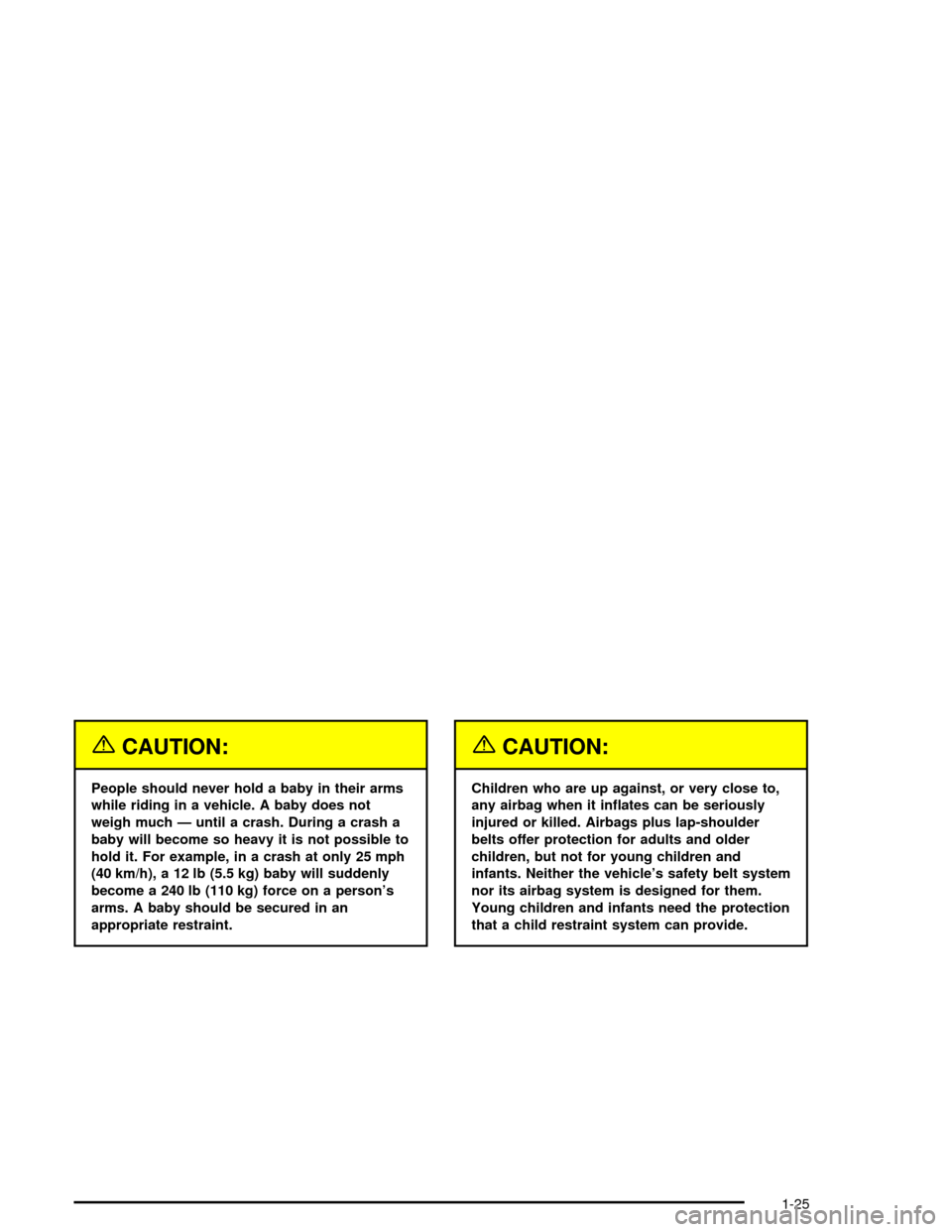2005 CHEVROLET CORVETTE child restraint
[x] Cancel search: child restraintPage 1 of 400

Seats and Restraint Systems........................... 1-1
Front Seats
............................................... 1-2
Safety Belts
.............................................. 1-7
Child Restraints
.......................................1-21
Airbag System
.........................................1-40
Restraint System Check
............................1-51
Features and Controls..................................... 2-1
Keys
........................................................ 2-3
Doors and Locks
......................................2-10
Windows
.................................................2-16
Theft-Deterrent Systems
............................2-18
Starting and Operating Your Vehicle
...........2-20
Mirrors
....................................................2-35
OnStar
®System
......................................2-41
HomeLink®Wireless Control System
...........2-42
Storage Areas
.........................................2-46
Roof Panel
..............................................2-52
Convertible Top
.......................................2-57
Vehicle Personalization
.............................2-68
Instrument Panel............................................. 3-1
Instrument Panel Overview
.......................... 3-4
Climate Controls
......................................3-25
Warning Lights, Gages, and Indicators
........3-32Driver Information Center (DIC)
..................3-49
Audio System(s)
.......................................3-78
Driving Your Vehicle....................................... 4-1
Your Driving, the Road, and Your Vehicle
..... 4-2
Towing
...................................................4-36
Service and Appearance Care.......................... 5-1
Service
..................................................... 5-3
Fuel
......................................................... 5-5
Checking Things Under the Hood
...............5-10
Rear Axle
...............................................5-43
Bulb Replacement
....................................5-44
Windshield Replacement
...........................5-48
Windshield Wiper Blade Replacement
.........5-49
Tires
......................................................5-51
Appearance Care
.....................................5-74
Vehicle Identi�cation
.................................5-84
Electrical System
......................................5-85
Capacities and Speci�cations
.....................5-92
Maintenance Schedule..................................... 6-1
Maintenance Schedule
................................ 6-2
Customer Assistance and Information.............. 7-1
Customer Assistance and Information
........... 7-2
Reporting Safety Defects
...........................7-10
Index................................................................ 1
2005 Chevrolet Corvette Owner ManualM
Page 7 of 400

Front Seats......................................................1-2
Manual Seats................................................1-2
Six-Way Power Seats.....................................1-2
Power Lumbar and Side Bolsters......................1-3
Heated Seats.................................................1-4
Reclining Seatbacks........................................1-4
Seatback Latches...........................................1-6
Safety Belts.....................................................1-7
Safety Belts: They Are for Everyone.................1-7
Questions and Answers About Safety Belts......1-11
How to Wear Safety Belts Properly.................1-12
Driver Position..............................................1-13
Safety Belt Use During Pregnancy..................1-19
Passenger Position.......................................1-20
Safety Belt Pretensioners...............................1-20
Safety Belt Extender.....................................1-20
Child Restraints.............................................1-21
Older Children..............................................1-21
Infants and Young Children............................1-24
Child Restraint Systems.................................1-27
Top Strap....................................................1-31Lower Anchorages and Top Tethers for
Children (LATCH System)...........................1-31
Securing a Child Restraint Designed for the
LATCH System.........................................1-33
Securing a Child Restraint in the Passenger
Seat Position............................................1-35
Airbag System...............................................1-40
Where Are the Airbags?................................1-42
When Should an Airbag In�ate?.....................1-45
What Makes an Airbag In�ate?.......................1-46
How Does an Airbag Restrain?.......................1-46
What Will You See After an Airbag In�ates?.....1-46
Airbag Off Switch..........................................1-48
Servicing Your Airbag-Equipped Vehicle...........1-51
Restraint System Check..................................1-51
Checking the Restraint Systems......................1-51
Replacing Restraint System Parts After
a Crash...................................................1-52
Section 1 Seats and Restraint Systems
1-1
Page 18 of 400

Q:If I’m a good driver, and I never drive far from
home, why should I wear safety belts?
A:You may be an excellent driver, but if you’re in an
accident — even one that isn’t your fault — you
and your passenger can be hurt. Being a good
driver doesn’t protect you from things beyond your
control, such as bad drivers.
Most accidents occur within 25 miles (40 km) of
home. And the greatest number of serious injuries
and deaths occur at speeds of less than 40 mph
(65 km/h).
Safety belts are for everyone.
How to Wear Safety Belts Properly
This part is only for people of adult size.
Be aware that there are special things to know about
safety belts and children. And there are different
rules for smaller children and babies. If a child will be
riding in your vehicle, seeOlder Children on page 1-21
orInfants and Young Children on page 1-24. Follow
those rules for everyone’s protection.
First, you will want to know which restraint systems your
vehicle has.
We will start with the driver position.
1-12
Page 26 of 400

Passenger Position
The passenger’s safety belt works the same way as the
driver’s safety belt. SeeDriver Position on page 1-13.
Safety Belt Pretensioners
Your vehicle has safety belt pretensioners for the driver
and right front passenger. Although you can not see
them, they are located on the buckle end of the safety
belts. They help the safety belts reduce a person’s
forward movement in a moderate to severe frontal and
near frontal crash.
Pretensioners work only once. If they activate in a
crash, you will need to get new ones, and probably other
new parts for your safety belt system. SeeReplacing
Restraint System Parts After a Crash on page 1-52.
Safety Belt Extender
If the vehicle’s safety belt will fasten around you, you
should use it.
But if a safety belt is not long enough, your dealer will
order you an extender. It is free. When you go in to
order it, take the heaviest coat you will wear, so
the extender will be long enough for you. To help avoid
personal injury, do not let someone else use it, and
use it only for the seat it is made to �t. The extender has
been designed for adults. Never use it for securing
child seats. To wear it, just attach it to the regular safety
belt. For more information, see the instruction sheet
that comes with the extender.
1-20
Page 27 of 400

Child Restraints
Older Children
Older children who have outgrown booster seats should
wear the vehicle’s safety belts.
Q:What is the proper way to wear safety belts?
A:If possible, an older child should wear a
lap-shoulder belt and get the additional restraint a
shoulder belt can provide. The shoulder belt
should not cross the face or neck. The lap belt
should �t snugly below the hips, just touching the
top of the thighs. It should never be worn over
the abdomen, which could cause severe or even
fatal internal injuries in a crash.
In a crash, children who are not buckled up can strike
other people who are buckled up, or can be thrown
out of the vehicle. Older children need to use safety
belts properly.
1-21
Page 28 of 400

{CAUTION:
Never do this.
Here two children are wearing the same belt.
The belt can not properly spread the impact
forces. In a crash, the two children can be
crushed together and seriously injured. A belt
must be used by only one person at a time.
Q:What if a child is wearing a lap-shoulder belt,
but the child is so small that the shoulder belt
is very close to the child’s face or neck?
A:Move the child toward the center of the vehicle, but
be sure that the shoulder belt still is on the child’s
shoulder, so that in a crash the child’s upper
body would have the restraint that belts provide.
1-22
Page 30 of 400

Infants and Young Children
Everyone in a vehicle needs protection! This includes
infants and all other children. Neither the distance
traveled nor the age and size of the traveler changes
the need, for everyone, to use safety restraints. In fact,
the law in every state in the United States and in
every Canadian province says children up to some age
must be restrained while in a vehicle.
Every time infants and young children ride in vehicles,
they should have the protection provided by appropriate
restraints. Young children should not use the vehicle’s
adult safety belts alone, unless there is no other choice.
Instead, they need to use a child restraint.
1-24
Page 31 of 400

{CAUTION:
People should never hold a baby in their arms
while riding in a vehicle. A baby does not
weigh much — until a crash. During a crash a
baby will become so heavy it is not possible to
hold it. For example, in a crash at only 25 mph
(40 km/h), a 12 lb (5.5 kg) baby will suddenly
become a 240 lb (110 kg) force on a person’s
arms. A baby should be secured in an
appropriate restraint.
{CAUTION:
Children who are up against, or very close to,
any airbag when it in�ates can be seriously
injured or killed. Airbags plus lap-shoulder
belts offer protection for adults and older
children, but not for young children and
infants. Neither the vehicle’s safety belt system
nor its airbag system is designed for them.
Young children and infants need the protection
that a child restraint system can provide.
1-25